
First written September 5th, 2013 (Rosh Hashanah 5774)
Augusta, GA – To the skeptics and the “doubting Thomas’s” Glyn Howard responds …
This is a follow-up to the announcement:
G Found It – U.S. World Record Mars Meteorite Discovery
G Found It - U.S. World Record Mars Meteorite
Discovery
March 27, 2013
http://www.rapidpressrelease.net/newswire/33463/g_found_it__us.asp
March 27, 2013/EIN World News Report: G Found It - U.S. World Record Mars Meteorite Discovery
March 27, 2013/EIN News.com: G Found It- U.S. World
Record Mars Meteorite Discovery
A great educational primer for studying
Mars meteorites and meteoritics before we begin:
"Anatomy of A Martian Meteorite
Poster and Information Packet"
Meteorites from Mars! Explore what they are made of, where scientists
hunt for them, and what we learn from them.
http://www.lpi.usra.edu/education/resources/s_system/marsPoster.shtml
http://www.lpi.usra.edu/education/resources/s_system/poster_lg.jpg
http://www.lpi.usra.edu/education/resources/s_system/fullpacket.pdf
A Metric Primer:
https://msu.edu/course/lbs/145/luckie/metric_primer.pdf
Megaconverter.com: Metric --> English
or English --> Metric
http://www.megaconverter.com/cv_classic.html
SGS Minerals Services
(utilized the results from their research department in Lakefield, Ontario, SGS provided whole rock oxides and trace element geochemistry analysis by ICP-MS (inductively coupled plasma mass spectrometry); these complete research results were provided without interpretation for both GSA and GSB.)
185 Concession St.
PO Box 4300
Lakefield, Ontario, K0L 2H0
Canada
t +1 705 652 2000
f +1 705 652 6365
SGS Website:
http://www.sgs.ca/en/Mining/Analytical-Services.aspx
SGS Services:
http://www.sgs.ca/en/Mining/Analytical-Services/Geochemistry.aspx
SGS overview and detailed desription of their
geochemistry capabilities:
http://www.sgs.ca/~/media/Global/Documents/Flyers%20and%20Leaflets/SGS-MIN-WA060-Overview-of-Geochem-Capabilities-EN-11.pdf
SGS analytical guide (see pgs.78-79 for coverting
to and from weight % , g/t , ppm, ppb etc.)
http://www.sgs.com/-/media/global/documents/brochures/sgs-analytical-guide-2016.pdf
Periodic Table of Elements: LANL
http://periodic.lanl.gov/index.shtml
(Note: All names of scientists, technicians, and their identities, and the identity of science labs utilized, are being withheld for security purposes and for the protection of the discovery, until such time when proper credit due can be given safely, publically.)
Let's begin ...
The Empirical Evidence of GSB:
With just two small key type typical identification samples from the many different sized specimens of this fragmented Mars meteorite find and discovery, I can lead the reader through the evidence and validate the discovery using "Glyn’s Sample B" (GSB, aka "The Real Black Beauty") and one other very choice sample ("Bikkurim") as a visual comparison. GSA is mentioned briefly in this article as a comparison, however, I won’t go into all the details concerning GSA at this time. Another evidence article will cover specimen GSA in full detail.
This is a "cliff notes" version from my more exhaustive study. This article will make the most sense to the meteoritics community: meteorite hunters, collectors, meteoriticists (scientists who study meteorites), as well as those who do all three, and also for those who are mineralogists, petrologists, as well as journalists with a strong science background. These are the audiences I'm addressing -- but primarily the meteoritics community.
Megascopic Evidence
Both GSA and GSB were both found in the same exact discovery site footprint on Earth with associated evidences somewhere in the U.S., and are key type typical identification representatives of many exact same paired meteoritic fragments.
(X) This indicates that they both derive from the same fall event and that they are both meteoritic.
Macroscopic Evidence
There are many GSB like Intermediate – Felsic extrusive igneous meteorite rock fragments from this meteorite find and discovery with fusion crust, partial fusion crust, or weathered fusion crust. There are many samples with regmalypts, flow-lines, drip-lines, roll-over edges, melt accumulate, characteristic fall shape and orientation, and impact shock fractures. There were a considerable amount of samples that were lying on the ground shattered that fit together like a 3D puzzle, and a few natural “Hammers” where one meteorite fragment slammed into another meteorite fragment on the ground, or hit a terrestrial rock and cracked in-situ or shattered as a result. There are samples that are highly magnetic like GSB, some slightly magnetic, and some not magnetic at all (don't worry, not all samples have been tested for magnetism; not even close.) All vary magnetically depending on the amount of Iron-oxides (FeO), Goethite (alpha-FeO(OH)), Magnetite (Fe3O4), or Hematite (Fe2O3) content, and not all are from the original Fe-Ni metal impactor that oxidized in the low-pressure Martian Carbon Dioxide (CO2) enriched atmosphere, and then injected shock metamorphosed micro impact "bullets" within the meteoroid mass prior to being ejected from the surface of Mars. Some of the Fe-Oxides were in-situ already within the igneous host rock and are therefore native Fe-Oxide grains within the Mars extrusive igneous rock. There are very important "Rosetta" stones that include both identical petrology like samples of GSA and GSB that are within the same meteorite rock sample and igneously combined, so therefore GSA and GSB are petrologically related and obviously from the same parent body origin.
(X) Therefore, this entire discovery is meteoritic.




Photo caption:
This is a stereogram image of one of my favorite collected small Mars meteorite samples from this U.S. WR Mars Meteorite Discovery. “Bikkurim,” means “First Fruits” in Hebrew that has been transliterated into English (the full transliteration means: First Fruits to The Name The Lord Yeshua HaMashiach, Jesus The Messiah). Everything about this small sample is a classic textbook example of a meteorite, including fall orientation. The top end-piece was fractured off at the discovery site. I found it about 50.0cm away from the larger main mass. It’s jet black Dacite. However, more than likely it has a large amount of micro-grains of Fe-Oxides or Goethite (alpha-FeO(OH)), or other, from the original impactor even more so than GSB, hence the many regmaglypts, and it's highly magnetic.
Microscopic Evidence
Utilizing the finest crafted quality, double polished thin-sections made from GSB, and an optical mineralogy polarizing/ore microscope, many classic examples of micro impact shock metamorphism effects are witnessed throughout the thin-sections of GSA and GSB. Impact shock metamorphism effects are definitive qualitative and quantitative empirical proof for meteorites of extra-terrestrial origin that can’t be falsified. They can only be duplicated by nuclear blast shock pressure waves passing through the host rock mineral grains. However, no nuclear bomb went-off in the backyard and neither at the discovery site.
Once again, impact shock metamorphism effects are one of the definitive diagnostic tests and proofs that rocks from space are indeed meteorites, and Earth features such as impact craters have meteoritic origins (excepting nuclear blast test sites), since normal terrestrial metamorphism can not duplicate these effects.
All of the following impact shock metamorphism effects at the micro-level are seen throughout the thin-sections of GSB: undulose extinction, planar fractures, planar deformation features (PDFs), decorative PDFs, shock melt veins and pockets, mosaicism, Plagioclase ---> Maskelynite, and Quartz ---> Coesite ---> Stishovite, high bi-refrigence, thetomorphs ---> incipient vaporization ---> vesicles and round vesicles, impact shock melt (localized), impact shock imbedded grains or blebs of metals, Fe-oxides or Goethite, minerals, or globules from the original impactor, and micro impact shock effects within opaque Fe-oxide grains (which I’m in the process of studying and which seems to be an un-described phenomenon and very unique.) The identified shock stage for GSB is (S5).
(X) Therefore, GSB is a meteorite of extra-terrestrial origin with a shock stage of (S5).












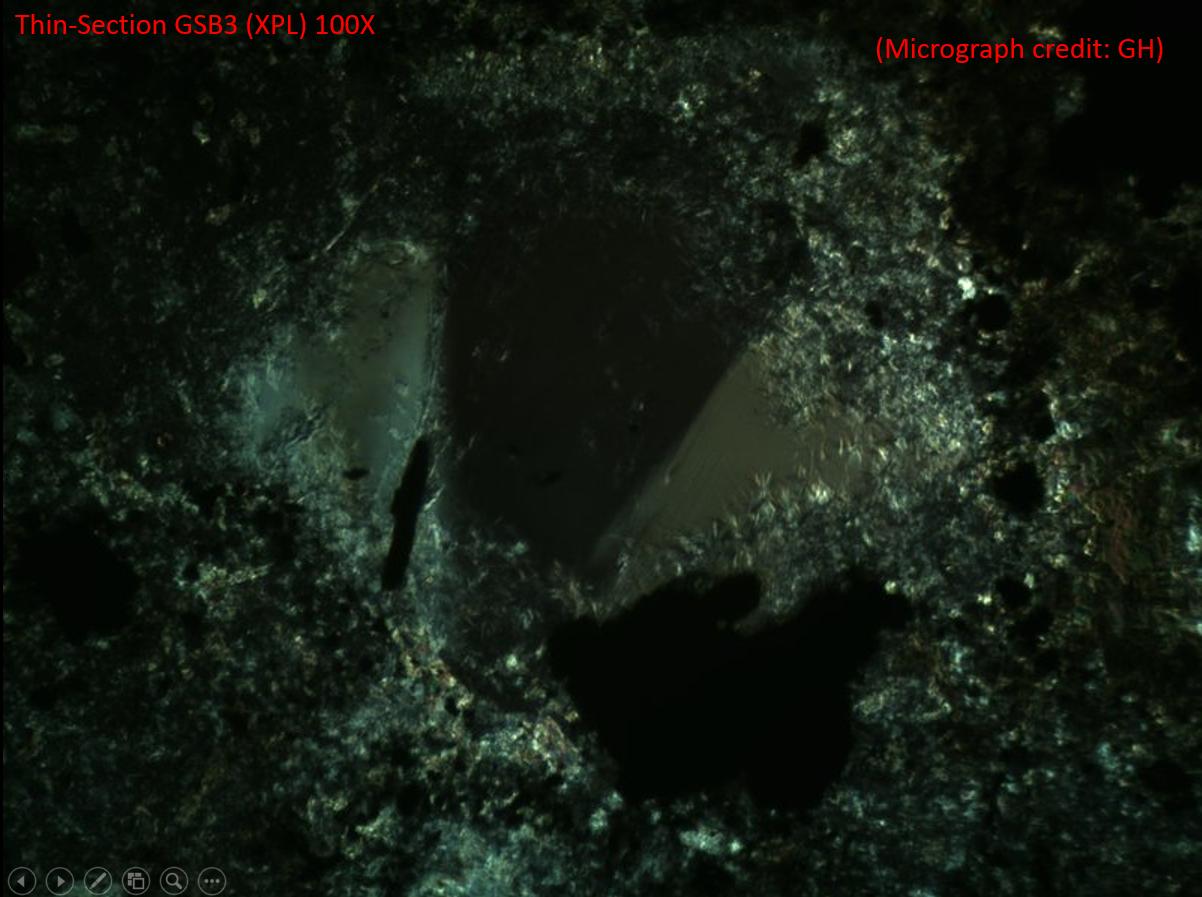


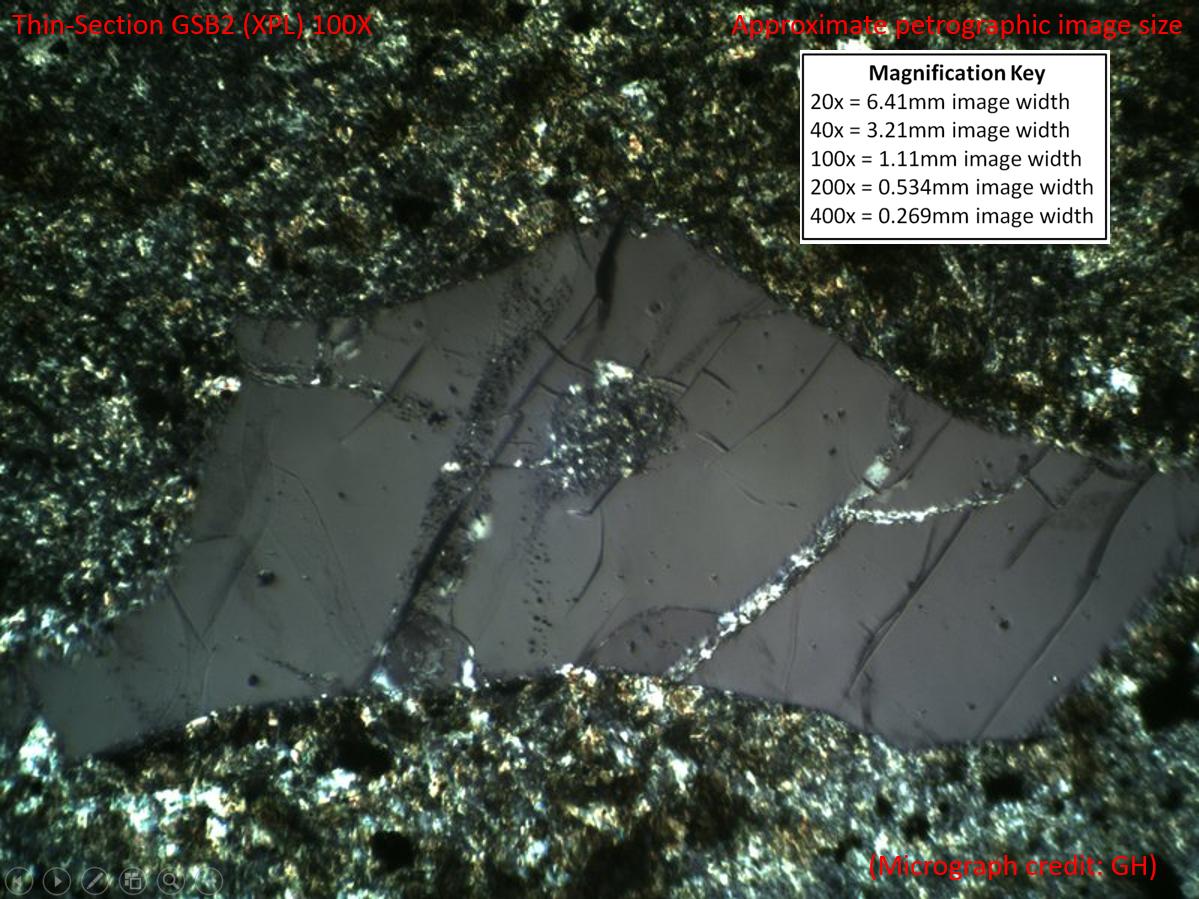
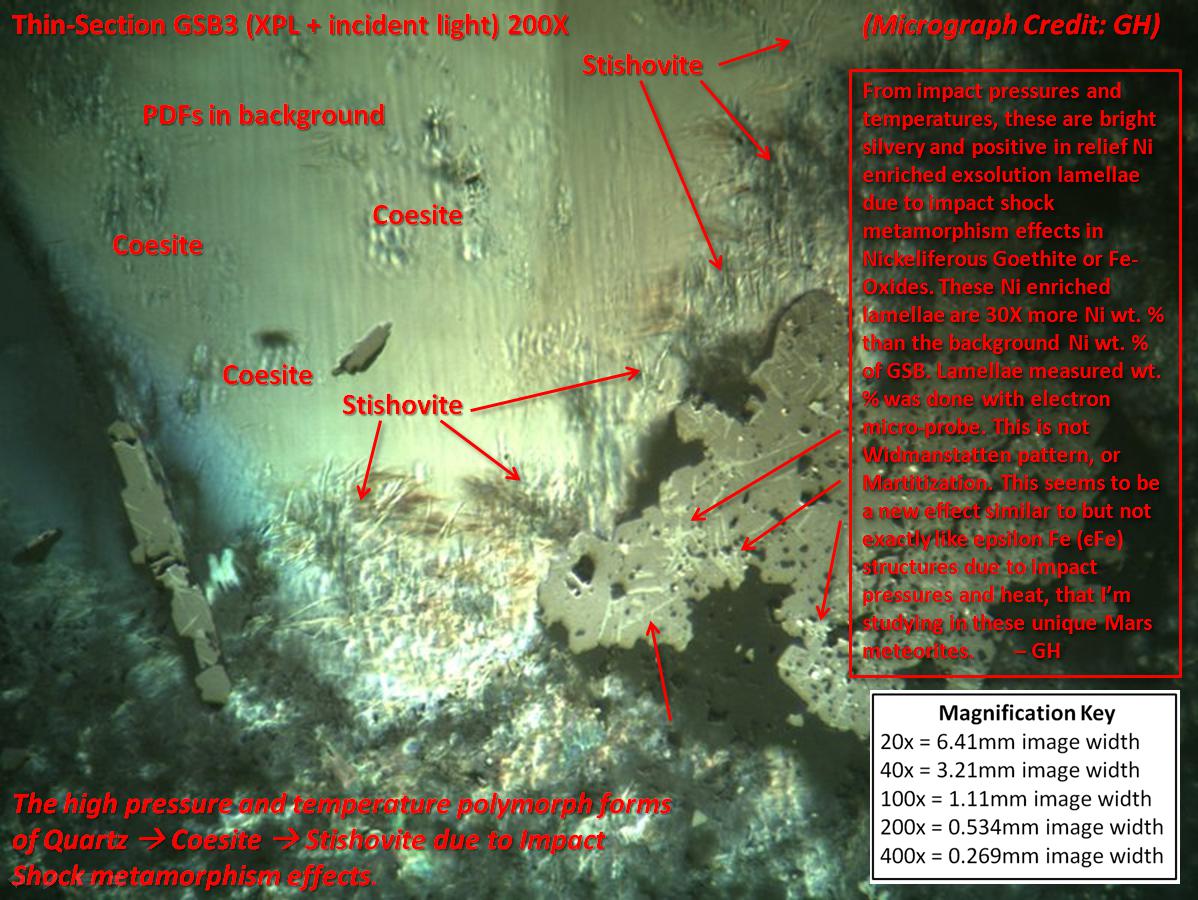
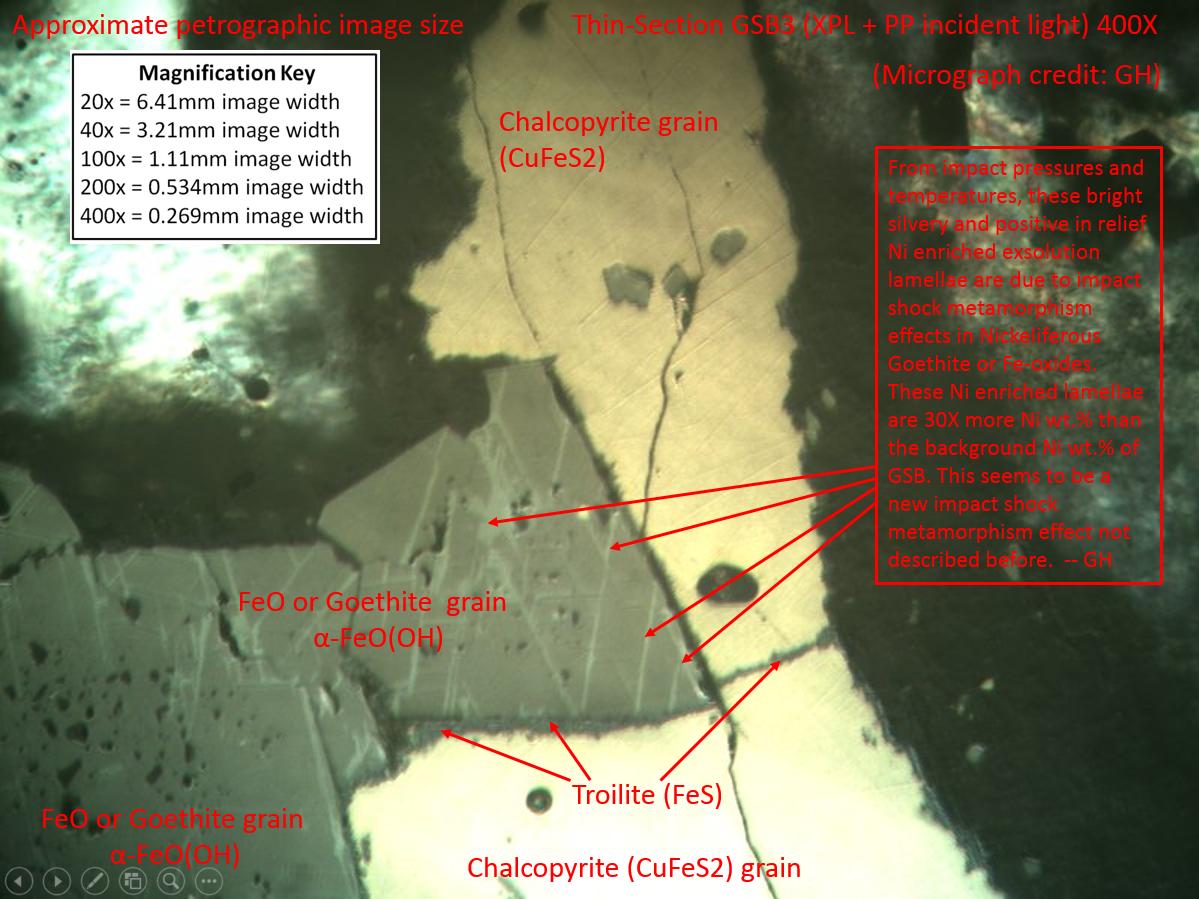
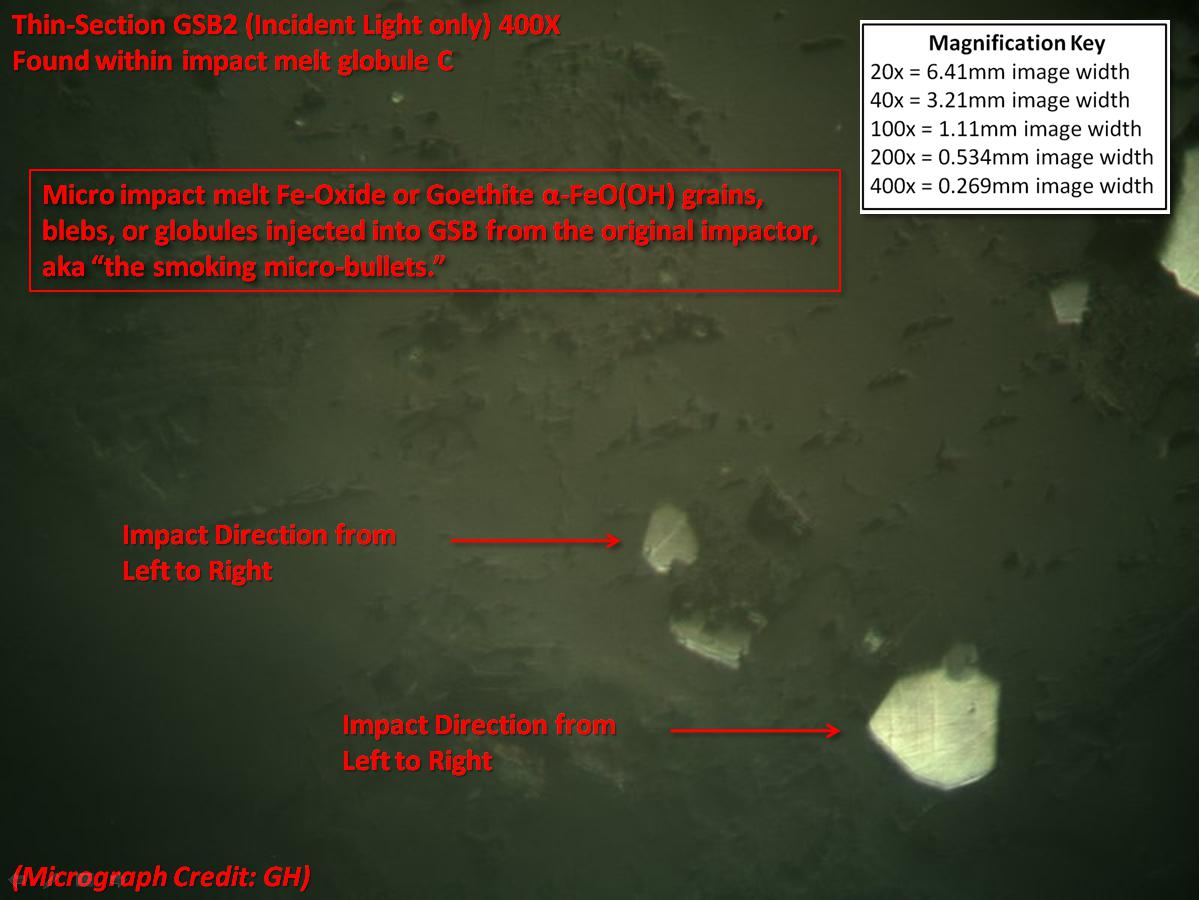






Resources for identifying opaque minerals using a petrographic ore microscope:
Virtual Atlas of Opaque and Ore Minerals in their Associations
http://www.atlas-of-ore-minerals.com/
Identification Table for Common Minerals in Thin Section
https://www.uwgb.edu/dutchs/Petrology/thinsect.htm

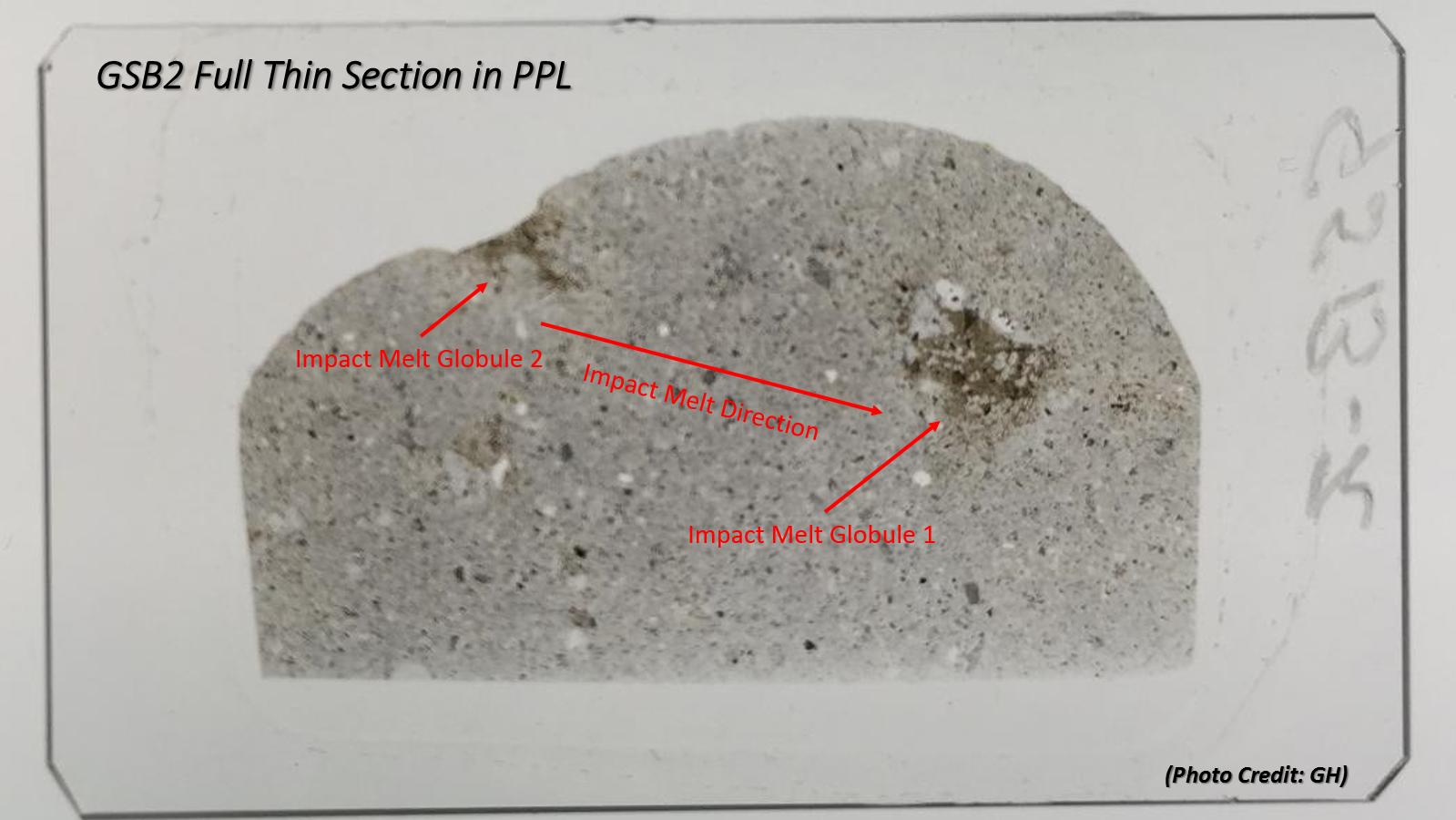




Petrology/Geochemistry Evidence
IUGS - QAPF modality classification (through optical mineralogy thin-section analysis): for plutonic and volcanic rocks which is based on the modal mineral proportions of quartz (Q), alkali feldspar (A) and plagioclase (P), or of alkali feldspar (A), plagioclase (P), and feldspathoids (F). Although difficult to do for igneous achondrite meteorites with a high shock stage value due to impact shock metamorphism effects, it can be done through careful thin-section examination, micrograph by micrograph, where mineral grains can clearly be identified and approximate % proportions can be assigned. Using IUGS - QAPF modality classification through thin-section analysis, GSB is a volcanic extrusive igneous rock, an Intermediate – Felsic (> 63 – 69% SiO2) "evolved lava" called Dacite. The color is jet black like obsidian, with an aphanitic texture, but not glassy.
There is the recent (2011) and significant North West African Mars meteorite discovery (NWA 7034) made public by the name of "Black Beauty." However, I must admit that this U.S. World Record Mars Meteorite Discovery and private identification of GSA and GSB pre-dates the discovery of "Black Beauty" by many years. Also GSB and many other meteorite samples from this WR discovery are truly the darkest jet-black color in the interior. I suppose that GSB will have to be called "The Real Black Beauty," to distinguish it from "Black Beauty." Also an additional interesting note, GSB and NWA 7034 have similar pyramidal orientation 3D fall shapes.
NWA 7034 "Black Beauty" Links:
Presentation on NWA 7034 "Black Beauty"
Another shorter concise presentation on NWA 7034.
IUGS - TAS classification (Total Alkali Silica): Another, more accurate way to determine the petrology of achondrite meteorites that have undergone a great deal of impact shock metamorphism effects is IUGS - TAS classification (Total Alkali Silica). However, this requires whole rock mineral oxide and trace element/REE analysis and data.
Utilizing one of the finest private industry mining analysis companies in North America, SGS and their science research division, and whole rock oxides and trace element geochemistry analysis by ICP-MS (inductively coupled plasma mass spectrometry), these results were provided without interpretation for both GSA and GSB. This private company is often utilized by university geology departments that would prefer another different and separate professional private company that specializes in these geochemistry studies to accomplish the whole rock oxide and trace element analysis and then provide the results in a very timely, accurate, and certified manner. Having a different or second science lab quantify the whole rock oxide results is best for keeping the study unbiased. For Earth scientists and geologists knowledgeable in geochemistry/petrology analysis, they can then take these raw data results and convert them using stoichiometry and geochemistry techniques to any data set required for igneous rock and/or meteorite analysis and classification. This I can do and this I have done.
The IUGS - TAS classification (Total Alkali Silica) is plotted on a graph with Y-axis: Na2O + K2O (wt. %) vs. X-axis: SiO2 (wt. %). For GSB these results are: Na2O + K2O (wt. %) = 2.4% + 1.8% = 4.2%; SiO2 (wt. %) = 63.8%. Therefore, (X,Y) = (63.8, 4.2). GSB is a Dacite. See the following article and an example of the IUGS – TAS classification graph as it relates to Mars meteorites: Mars Crust Made of Basalt, by PhD McSween et al. Plot GSB and see that it is indeed a Dacite and similar to Mars Spirit Rover results at Gusev Crater for "Rock Rat" and "Rock Brush" analysis.

Graphic Resources:
Mars Crust Made of Basalt
http://www.psrd.hawaii.edu/May09/Mars.Basaltic.Crust.html
Originally from McSween et al., 2009, Science, v.324, doi: 10.1126/science. 1165871.
Once again, GSB is a volcanic extrusive igneous rock, an Intermediate – Felsic (> 63 – 69% SiO2), GSB is at 63.8% SiO2, an "evolved lava" called Dacite. The color is jet black like obsidian, with an aphanitic texture, but not glassy.
Dacite resources:
Dacite from the type-locality Poieni, Vladeasa Massif, Romania. Geological Institute of Romania
Igneous rocks by composition from dacite wiki site:

GSB and other discovered samples collected at the discovery site are all meteorites from the same fall event. They aren’t Iron meteorites. They aren’t Stony-Iron meteorites. They are Stony meteorites. They aren’t Chondrites, since they don’t have Chondrules. They are Achondrites (without Chondrules), and are therefore from a differentiated planetary parent body (PB). The possible differentiated planetary bodies are: Mercury, Venus, Earth, The Moon (Lunar), Mars, and Asteroid 4 Vesta at this time.
(X) Therefore, GSB is a achondrite meteorite from a differentiated planetary parent body (PB) of extra-terrestrial origin with a shock stage of (S5). The rock classification of GSB is a volcanic extrusive igneous rock, an Intermediate – Felsic (> 63 – 69% SiO2), GSB is at 63.8% SiO2 an "evolved lava" called Dacite. This suggests a highly geologically evolved planetary parent body, similar to Earth. This also suggests the PB is either Venus or Mars. However, so far we haven’t identified meteorites from Venus (yet). It will be difficult. The geochemistry will be very similar to Earth and therefore hard to distinguish. Therefore, the physical geochemistry evidence leans toward Mars.
Planetary Parent Body (PB) Evidence
3 validating geochemistry PB tests for GSB are presented here, with a total of 7 independent geochemistry tests that have been done that all confirm the PB = Mars:
· PB Validation #1: GSB Results Utilizing the article – Pigeonholing Planetary Meteorites: The Lessons of Misclassification of EET87521 and ALH84001
http://www.lpi.usra.edu/meetings/lpsc1994/pdf/1399.pdf
Granitic and anorthositic = possible = Yes (Dacite).
(Dacite has now been found on Mars in the Syrtis Major Volcanic Province using THEMIS remote sensing. See following sources: ...)
Dacite on Mars:
Complex
Lavas in Nili Patera
Evolved
lavas at Syrtis Major
Mars
has complex volcanic processes
Plagioclase % Anorthite = 44% for GSB (within 44-54% for Mars) = Yes
Oxidation (metal oxides) = Yes
Iron metal = No (in-other-words, oxides only, no pure Fe)
Sulfides = Yes
Secondary Alteration: Hydrous = Yes
Minerals: CO3, and SO4 = Yes (Hydrous)
Bulk Comp. Fe/Mn (and FeO/MnO) = 119.75 (and 119.31) for GSB (within 35-50) = No. Too High due to large amounts of Fe-Oxides (although it matches the Moon and Angrite values) from the original Fe-Ni Asteroid impactor and less Mn due to Dacite being an “evolved lava” (extrusive igneous volcanic rock) meaning the Mn would more than likely settle out in the magma chamber. That's a speculative possibility.
(X) Conclusion, Parent Body = Mars
· PB Validation #2: GSB Results ...
Resource: From the research article, American Mineralogist: Determination of planetary basalt parentage: A simple technique using the electron microprobe, J.J. Papike, J.M., Karner, and C.K. Shearer
Using the J.J. Papike et al., method of achondrite meteorite planetary parentage (from the Graph: Fe/Mn ratios within Pyroxene or Olivine (Y-axis) vs. %Anorthite (X-axis) ) and fine-tuning the technique, using Optical Mineralogy (the Michel-Levy Method for determining plagioclase % Anorthite) and/or Electron Microprobe Analysis, the Parent Body of GSA = 46% Anorthite = Mars (on the x-axis) and GSB = 44% Anorthite = Mars (on the x-axis).
GSB: Plagioclase, % Anorthite = 44% (within 44-54% for Mars); An44Ab56 = Andesine.
Therefore, on the x-axis the plagioclase percentages directly indicate that for both GSA and GSB the PB is Mars.
Y-axis values are the Fe/Mn ratios within pyroxene or olivine. When there are no pyroxene or olivine grains to find, or it is difficult to see them or identify them due to impact shock metamorphism effects, then fine-tuning the technique using the whole rock bulk ratio of FeO/MnO = y-axis, can be substituted and used from whole rock elemental oxide analysis. See graph below.
(X) Conclusion, Parent Body = Mars
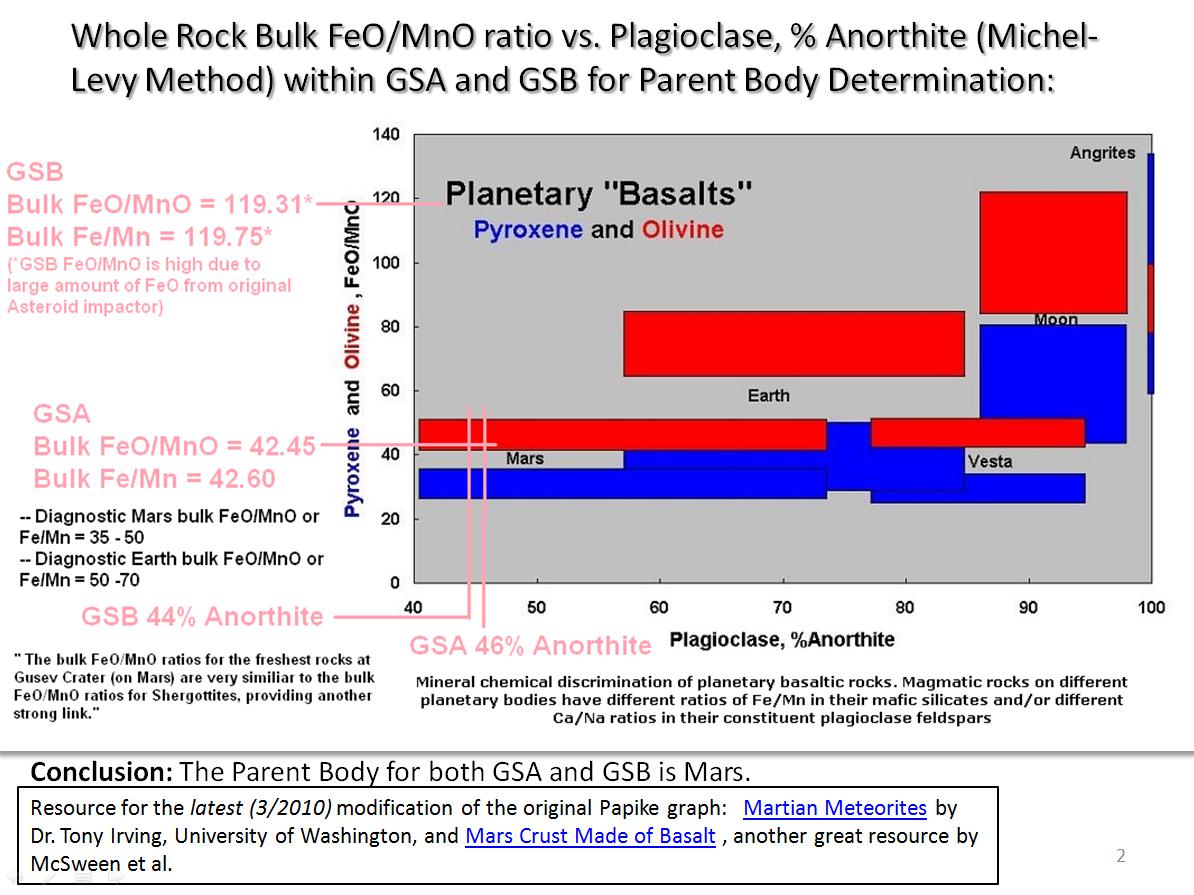
Graphic Resources:
http://www.imca.cc/mars/martian-meteorites.htm
http://www.imca.cc/mars/martian-meteorites-list.htm
Original resource/graphics from the research article, American Mineralogist: Determination of planetary basalt parentage: A simple technique using the electron microprobe, J.J. Papike, J.M., Karner, and C.K. Shearer
· PB Validation #3: GSB Results ...
From ICP-MS whole rock and trace mineral analysis:
Mg/Si (wt. ratio) vs. Al/Si (wt. ratio) graph used as a definitive diagnostic test to discriminate between Mars and Earth rocks ...
GSB:
Mg/Si (wt.% ratio) = (y-axis) = 0.04464388
Al/Si (wt.% ratio) = (x-axis) = 0.301722064
(x,y) = (0.30, 0.04)
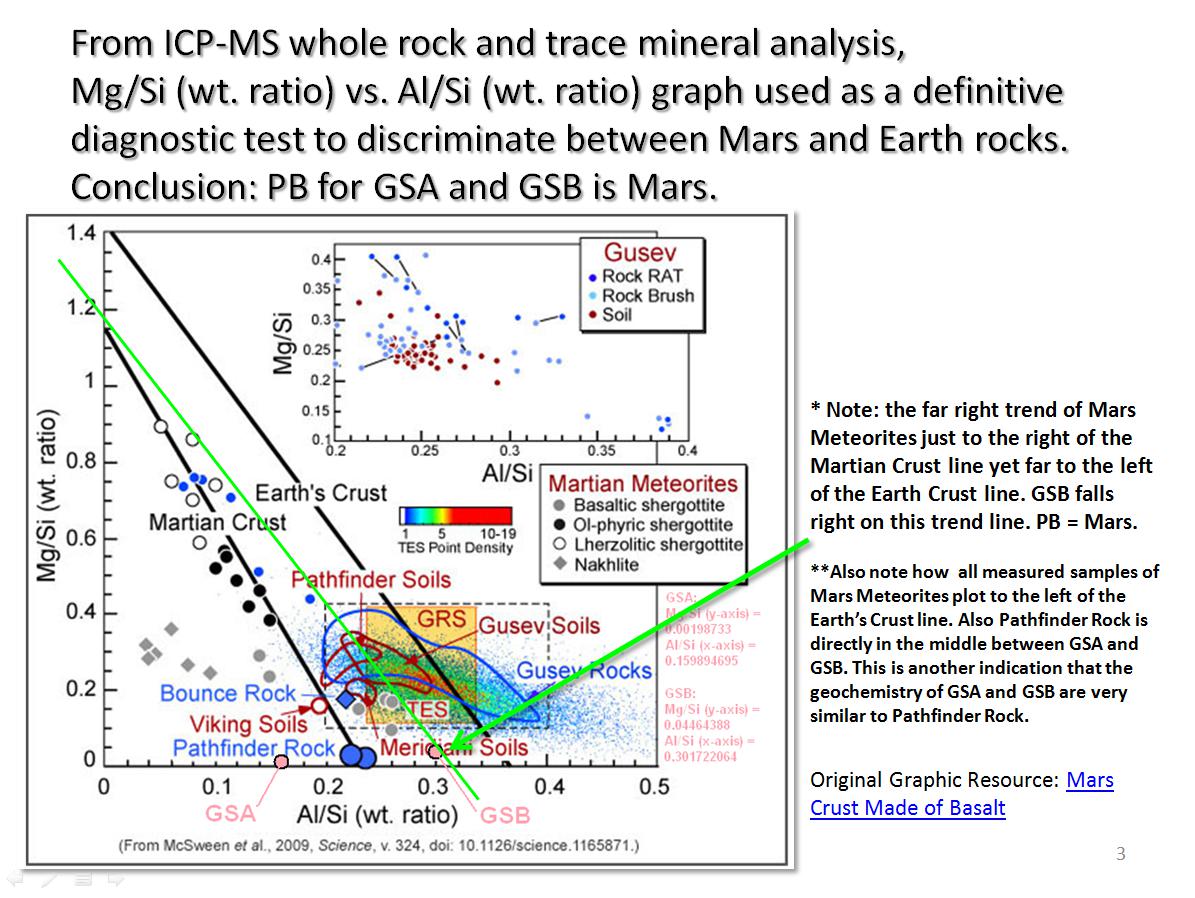
Graphic Resources:
Mars Crust Made of Basalt
http://www.psrd.hawaii.edu/May09/Mars.Basaltic.Crust.html
From McSween et al., 2009, Science, v.324, doi: 10.1126/science. 1165871.
(X) Conclusion, Parent Body = Mars.
Five additional tests that validate the parent body for GSB as Mars has been done: ppm K vs. ppm La graph, K2O (wt.%) vs. La (ppm) graph, Cr (ppm) vs. Mg # graph, and MnO (wt.%) vs. FeO (wt.%) graph (last graph indicates not from Earth, but inconclusive for Mars); GSA/vfcl, GSB/vfcl, vfcl vs. REE (g/t) proves GSA and GSB match the same PB.
Economic Astrogeology Evidence
Again, the following concentration of trace element amounts were provided by one of the finest private industry mining analysis companies in North America, and their science research division, utilizing whole rock oxides and trace element geochemistry analysis by ICP-MS (inductively coupled plasma mass spectrometry). These results were provided without interpretation for both GSA and GSB. Only GSB concentrations are listed below. Obviously, in-situ metal and mineral resources are needed for colonizing Mars.
(GSA strategic elemental concentration values are even more incredible, and with many elemental profitable concentrations in comparison to Earth).
(Note: micro-gram/g = ppm = g/t; wt. % (x 10,000) = g/t )
Strategic elements within a theoretical 1 tonne block of GSB listed in order of concentration:
• Aluminum (Al) (13) = Al = 8.9994706 wt. % = 89,994.706g/t = ppm = 89.994706kg/t of Al
(on Earth 24 – 32 wt. % = 240,000 – 320,000g/t = ppm = 240.0 – 320.0kg/t or more for Al is profitable)
• Iron (Fe) (26) = Fe = 6.957036 wt. % = 69,570.36g/t = ppm = 69.57036kg/t of Fe
(on Earth 15 – 64 wt. % = 150,000 – 640,000g/t = ppm = 150 – 640kg/t or more for Fe is profitable)
• Titanium (Ti) (22) = Ti = 0.4916067 wt. % = 4916.0671g/t = ppm = 4.9160671kg/t of Ti
(on Earth 21.5 – 86.0 wt. % = 215,000 – 860,000g/t = ppm = 215 – 860kg/t or more for Ti is profitable)
• Barium (Ba) (56) = Ba = 630.0g/t = ppm = 0.063 wt. % = 0.63kg/t of Ba
(on Earth 0.18 - 0.81 wt.% = 1800.0g/t - 8100.0g/t or more for Ba is profitable. Example Mountain Pass Mine in CA: 1800.0 - 8100.0micro-grams/g)
• Copper (Cu) (29) = Cu = 0.05 wt. % = 500g/t = ppm = 0.5kg/t of Cu
(Recall: 1 Troy Once = 31.1g; 500.0g of Cu = 16.1 Troy Ounces)
(on Earth 0.4 - 1.16 wt. % = 4000.0 – 11,600.0g/t = ppm = 4.0 – 11.6kg/t or more for Cu is profitable)
• Zinc (Zn) (30) = Zn = 410.0g/t = ppm = 0.041 wt. % = 0.41kg/t of Zn
(on Earth XX.X% = XXXX.Xg/t or more for Zn is profitable)
• Strontium (Sr) (38) = Sr = 290.0g/t = ppm = 0.0290 wt. % = 0.29kg/t of Sr
(on Earth XX.X% = XXXX.Xg/t or more for Sr is profitable)
• Cobalt (Co) (27) = Co = 43.0g/t = ppm = 0.0043 wt. % = 0.043kg/t of Co
(on Earth XX.X% = XXXX.Xg/t or more for Co is profitable)
• Nickel (Ni) (28) = Ni = 42.0g/t = ppm = 0.0042 wt. % = 0.042kg/t of Ni
(on Earth XX.X% = XXXX.Xg/t or more for Ni is profitable)
• Lanthanum (La) (57) = La = 33.0g/t = ppm = 0.0033 wt. % = 0.033kg/t of La
(on Earth XX.X% = XXXX.Xg/t or more for La is profitable)
• All the REE concentrations in GSB were measured see table and graph below
• Lead (Pb) (82) = Pb = < 30.0g/t = ppm = 0.003 wt. % = < 0.03kg/t of Pb
(on Earth XX.X% = XXXX.Xg/t or more for Pb is profitable)
• Silver (Ag) (47) = Ag = 3.0g/t = ppm = 0.0003 wt. % = 0.003kg/t of Ag
(Recall: 1 Troy Ounce = 31.1g; 3.0g/t of Ag = .096463 Troy Ounces/t)
(on Earth 3.0 – 60.0 g/t = (ppm) = 0.0003 – 0.006 wt. % or more for Ag is profitable)
• Gold (Au) (79) = Au = was not analyzed or measured (although I suspect it will fall within Earth profitable concentrations when analyzed.)
(on Earth 0.0001 - 0.001 wt. % = 1.0 – 10.0g/t or more for Au is profitable)
• Platinum Group Metals (PGMs) were not analyzed or measured (although I suspect they will fall within Earth profitable concentrations when analyzed.)
(on Earth XX.X% = XXXX.Xg/t or more for PGMs is profitable)
On Earth typical mining ore-body concentrations for “The Royal Group” (Group 11: Copper (Cu), Silver (Ag), Gold (Au)) for profitability are at least:
• Copper (Cu):
Porphyry 0.4 - 1.16 wt. % = 4000.0 – 11,600.0g/t = (ppm) = 4.0 – 11.6kg/t
• Silver:
0.0003 – 0.006 wt. % = 3 – 60 g/t = (ppm)
Most often mined as a byproduct of another more profitable metal ore.
• Gold:
HQ underground: 0.0008 – 0.001 wt. % = 8 – 10 g/t = (ppm)
LQ underground: 0.0004 – 0.0006 wt. % = 4 – 6 g/t = (ppm)
Open pit: 0.0001 – 0.0004 wt. % = 1 – 4 g/t = (ppm)
Table and graph showing all REE concentrations for GSA and GSB, and that the profiles for each are very similar, indicating the PB is the same for both and from a similar petrology/lithology Mars occurrence.


(X) Conclusion, if GSB were a one tonne typical ore sample from a massive VMS deposit on Mars, then GSB has indications of mineable concentrations comparable to Earth for Silver (Ag). Although not at high concentrations, non-the-less, GSB has very useable concentrations for many other strategic metals that are needed for the habitability of Mars.
(As for GSA, it’s a very different story. There are several strategic metals that are both in very useable and very high concentrations (g/t) when compared to similar strategic and profitable ore concentrations here on Earth.)
Meteorite Classification
Meteorite: Stony
Differentiated: Achondrite
Clan: Mars
Group or Class: New Felsic and Intermediate – Felsic Igneous Extrusive (Volcanic) Groups (or classes) separate from the Mafic SNCs will have to Be Established
GSA: Felsic, Rhyolite with blebs of Phyllosillicates (such as Serpentine) (Color: tan/green – mottled, with a porphyritic texture.)
GSB: Intermediate – Felsic, Dacite (Color: jet black – obsidian like, with a aphanitic texture, not glassy.)
GSA and GSB are both Mars surface extrusive igneous volcanic rocks, also known as “Evolved Lavas.”
Shock Stage: GSA = S4; GSB = S5
Weathering Grade: GSA = W4; GSB = W4
(W4: complete (>95%) oxidation of metal and troilite, but no alteration of silicates)

Further Speculation and Hypotheses
· Impact shock metamorphosed grains of Calcium Carbonate (CaCO3), and Calcium Sulfate "Gypsum" (CaSO4), mineral grains exist within GSA and GSB, indicating water content present when these Mars surface volcanic extrusive igneous rock types or "evolved lavas" were formed. These grains were first found via optical mineralogy techniques and then micrograph images taken, followed by electron micro-probe analysis for mineral ID verification.
· Where did this large differentiated extrusive volcanic rock mass actually originate and then launch from off the surface of Mars? My hypothesis is the Syrtis Major Volcanic Planum Province, from the flanks of the Syrtis Major Shield Volcano. Several large impact craters exist along the flanks of the Syrtis Major Shield Volcano massive, and PhD McSween et al., discovered through remote sensing using THEMIS Mars imaging data, that Dacite and one other very noteworthy igneous rock type granite, have both been discovered within the Syrtis Major Volcanic Province. The other igneous rock type THEMIS discovered that matches GSA very closely, is Granite, the igneous intrusive rock form and the same in geochemistry to that of the igneous extrusive rock form of Rhyolite. GSA is Rhyolite. Also Serpentine (a Phyllosilicate mineral) has been discovered in the region of Nilli Fossae just to the NE of the Shield Volcano Syrtis Major. (Additional Serpentine resources: #1 and #2).
Phyllosilicates - Serpentine on Mars:
Geologic
setting of serpentine deposits on Mars
Geology
of possible Martian methane source regions
Early Mars Environments Revealed Through Near-Infrared
Spectroscopy of Alteration Minerals
by Bethany List Ehlmann (PhD dissertation)
https://repository.library.brown.edu/studio/item/bdr:11132/
At least three rock forms from this WR Mars Meteorite discovery match with what has been remotely sensed and identified in the Syrtis Major Planum Province: Dacite, Rhyolite (actually granite but geochemically identical), Serpentine (a Phyllosilicate mineral). Since these Mars meteorites must have originated in a Volcanogenic Massive Sulfide (VMS) deposit from a volcanic formation on Mars, such as a shield volcano as an example, statistically the chances are greatly increased that it may have originated in the Syrtis Major Planum region.
There is no way to be absolutely certain at this time where a Mars meteorite originates from the surface of Mars precisely, geologically, and geographically from the planetary parent body, but this is an interesting hypothesis. Perhaps one day we will be able to do so with on-site and in-situ geochemistry analysis on Mars with our Astronauts exploring, hiking and climbing the planet, and thereby match historic Mars meteorites that have fallen to Earth with the actual launch locations on Mars. I would like to think so.
Estimated crystallization age of these Phyllocilicates in the Nilli Fossae and Syrtis Major Planum region of Mars are estimated to be older than early Heperian, at the Noachian period (>3.8 B years), since they underlie the more recent extrusive early Hesperian volcanic rock forms that lie above layered on top. See the two articles below.
Resources:
· Concerning original petrologic crystallization formation age on Mars (Geological History of Mars), if my hypothesis is correct and the estimated geologic age of the Syrtis Major Planum Province on Mars is correct, using crater counts, then I would think this Mars meteorite discovery will absolute radiometric age-date to about the Hesperian Age = 3.8 to 3.0B ybp. On Earth, VMS deposits are typically formed around 3.4B ybp. If GSA and GSB did originate in the Syrtis Major Shield Volcano province, and VMSs on Mars occurred near the same time on Mars as on Earth, speculating only, then similarly 3.4B would put the crystallization age of GSA and GSB right in the middle of the Hesperian Age, at the end of the Early Hesperian Epoch range of 3.8 to 3.4B ybp for Mars.
From the mainpage: As stated, my hypothesis is the VMS deposit region of origin could statistically be the Syrtis Major Planum, aka the Syrtis Major Shield Volcano (eHV). If this hypothesis is correct, then I anticipate that the original igneous formation crystallization radiometric ages for a major portion of this U.S. WR Mars Meteorite Discovery should date within the early Hesperian epoch (approx. Mars Hesperian epoch is 3.8 to 3.4B years). See the detailed new Geologic Map of Mars produced by NASA.
· The following radiometric isotopic tests must be eventually performed on GSA and GSB: original crystallization age, impact/launch/ejection age, cosmic-ray exposure age, and terrestrial age, and as well, these tests must be performed on many other specimens for repeatability and verification.
· Terrestrial age: using relative age dating field techniques, it is my hypothesis that the terrestrial age of this U.S. WR Mars Meteorite Discovery is < 13,000 years. This can be verified by absolute age dating techniques to determine terrestrial ages (how long have the meteorites been sitting here in-situ on Earth).
· "Laser fluorination analysis of oxygen isotopes (16-O,17-O,18-O), and noble gas analyses from mineral glass to validate trapped Martian atmosphere should be done. These tests shall validate that the origin is Mars, since all other tests validate they are meteorites, from a differentiated planetary body, and the PB is Mars." The noble gas analyses within quartz will validate Mars atmospheric composition when first igneously crystallized.
· Search for fossilized evidence of crypto-endolithic biomorphs of previous life-forms to verify the possibility for the presence of microbial life on early Mars.
· Much of PhD Tony Irving’s Mars "wish list" is now accomplished:
http://www.imca.cc/mars/martian-meteorites.htm
http://www.imca.cc/mars/martian-meteorites-list.htm
In time, there are many more wonderful scientific discoveries from this U.S. WR Mars Meteorite Discovery to be shared. One step at a time.
Contact:
Ann Cain, PR Assistant
SMS, LLC
Project Management & Public Relations
Augusta, GA
Telephone: (706) 414-5730
Email: gfndit[at]hotmail.com




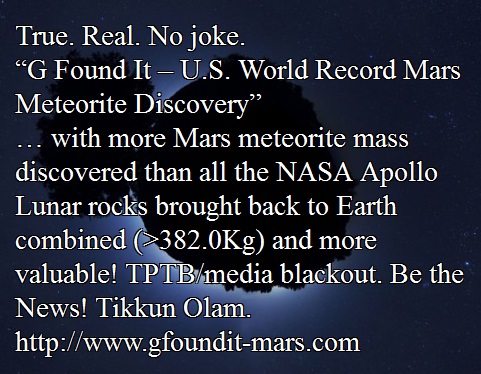


Note: All images or quoted written works are used under Fair Use policies for News, Research, Comparative studies, and Educational purposes. Credit and original urls for all sourced works are given as often as possible.
